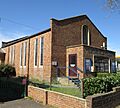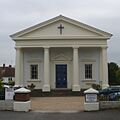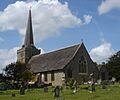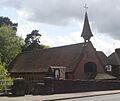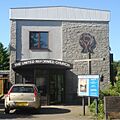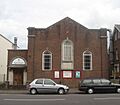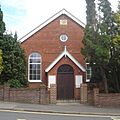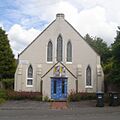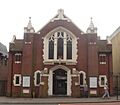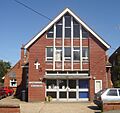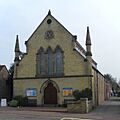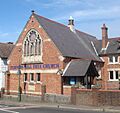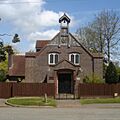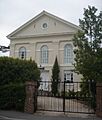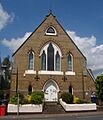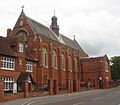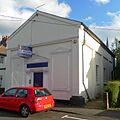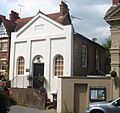List of places of worship in Mid Sussex facts for kids
Mid Sussex is a district in West Sussex, England. It's home to many towns and villages like Burgess Hill, Haywards Heath, and East Grinstead. This area has over 110 places where people can worship. Most of these are churches, but there are also mosques and other religious buildings. Some of these buildings are very old and have a lot of history!
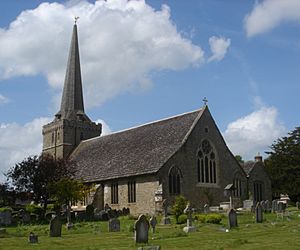
Many of these places of worship are "listed buildings." This means they are officially recognized as having special architectural or historical importance. It's like being on a special list to protect them! There are three levels of listed status:
- Grade I: These are buildings of "exceptional interest," meaning they are super important.
- Grade II*: These are "particularly important buildings" that are more than just special.
- Grade II: These are buildings of "special interest."
Most Christian churches in Mid Sussex belong to the Diocese of Chichester (for Anglican churches) or the Diocese of Arundel and Brighton (for Roman Catholic churches).
Contents
Who Lives Here? Religious Beliefs
In 2021, a survey (called a census) showed that 152,569 people lived in Mid Sussex. Here's how they identified their religious beliefs:
- Christians: About 47.92% of people said they were Christian. This is a bit higher than the average for all of England.
- No Religion: About 42.08% said they had no religious affiliation. This is also higher than the average for England.
- Other Religions: Smaller numbers of people identified as Muslim (1.21%), Hindu (1.03%), Buddhist (0.38%), Jewish (0.21%), and Sikh (0.1%). These numbers are generally lower than the average for England.
- Not Stated: About 6.34% of people chose not to say what their religion was.
How Churches Are Organized
Anglican churches in Mid Sussex are part of the Diocese of Chichester. This diocese has a main church called a cathedral in Chichester. The churches are grouped into smaller areas called "deaneries."
For example:
- The Rural Deanery of Cuckfield includes churches in Haywards Heath, Ardingly, Balcombe, Cuckfield, and many other villages.
- The Rural Deanery of East Grinstead covers churches in East Grinstead, Ashurst Wood, Copthorne, and Turners Hill.
- The Rural Deanery of Hurst includes churches in Burgess Hill, Hurstpierpoint, and nearby villages like Albourne and Clayton.
Roman Catholic churches in Mid Sussex are part of the Diocese of Arundel and Brighton, which has its cathedral in Arundel. For instance, the church in Haywards Heath is linked with churches in Horsted Keynes and Staplefield. Burgess Hill has its own Roman Catholic church.
Amazing Places of Worship in Mid Sussex
Mid Sussex is home to many beautiful and historic places of worship. Here are a few examples:
- St Bartholomew's Church, Albourne: This Anglican church has parts that are over 800 years old! It was rebuilt in 1853, but still has ancient features like a medieval font.
- St Peter's Church, Ardingly: Founded in the late 1000s, this church was rebuilt around 1350 in a fancy style called Decorated Gothic.
- St Mary's Church, Balcombe: This small stone church has an ancient tower and a unique octagonal spire.
- St Mary Magdalene's Church, Bolney: This church started in the 1100s and has had many parts added over the centuries, including a tower in 1538.
- St John the Evangelist's Church, Burgess Hill: Built in 1863, this church has a tall spire and is made of red, yellow, and black bricks.
- St John the Baptist's Church, Clayton: This very old church has amazing 12th-century wall paintings that are unique in England!
- Holy Trinity Church, Cuckfield: Most of this church was built between 1250 and 1340. Its thin, shingled spire is the oldest part.
- St Swithun's Church, East Grinstead: This church was rebuilt in 1789 after the original fell apart. It features beautiful stained glass.
- St Wilfrid's Church, Haywards Heath: Built in the 1860s, this church has a tall tower with 11 bells and stained glass showing soldiers from World War I.
- Mid Sussex Islamic Centre, Haywards Heath: This building has a long history, starting as a Congregational chapel, then an Anglican church, and even a Scout hut before becoming a mosque in 2010.
- St Giles' Church, Horsted Keynes: This church dates back to the 1100s and 1200s, with a tall, narrow spire and beautiful stained glass.
- Holy Trinity Church, Hurstpierpoint: Rebuilt in the 1840s, this large church has Flemish-style stained glass and a 13th-century font.
- All Saints Church, Lindfield: Mostly from the 1300s, this church has a tall shingled spire at its west end.
- Holy Trinity Church, Poynings: Built around 1370, this church has stained glass from the 1400s and a window from Chichester Cathedral.
- Church of the Transfiguration, Pyecombe: This church, dating from around 1170, has a unique "Tapsel gate" in its churchyard, which is only found in Sussex.
- St Mary's Church, Slaugham: This church from the 1100s and 1200s has a square font made of local marble that is as old as the building itself.
- St Peter's Church, Twineham: This church was built entirely of brick in the 1500s, which was very early for a brick church!
- Abbey Church of our Lady Help of Christians, Worth Abbey: This modern Roman Catholic church, built from the 1960s onwards, is the largest church in Sussex, able to hold 1,400 people.
Places of Worship That Have Changed
Some buildings that were once places of worship in Mid Sussex are now used for other purposes. This shows how communities change over time.
- St John the Evangelist's Church, Ansty: This small chapel, built in 1879, was used as an Anglican mission church but is now a house.
- Ardingly Congregational Fellowship Church: This red-brick chapel, built in 1885, was once a busy place of worship but is now a wellbeing centre.
- Providence Chapel, Bolney: Built in 1858, this Baptist chapel was used for worship until 1962 and is now a house.
- Providence Strict Baptist Chapel, Burgess Hill: This chapel, built in 1875, was converted into flats in 1999.
- Cuckfield United Reformed Church: Originally a Congregational chapel from the 1820s, this building became an office in 1979.
- Priory of Our Lady of Good Counsel, Haywards Heath: This beautiful building, built for nuns between 1886 and 1898, was also Haywards Heath's first Roman Catholic church. It is now a restaurant.
- St Luke's Church, Hurstpierpoint: This Roman Catholic church, which started as two cottages converted in 1925, closed around 2020.
- St Andrew's Church, Warninglid: This church, built in 1935, was sold for residential use in 2009.
See also
- Grade I listed buildings in West Sussex
- List of demolished places of worship in West Sussex
Images for kids
















